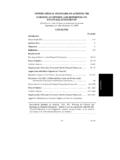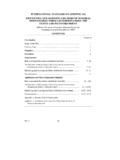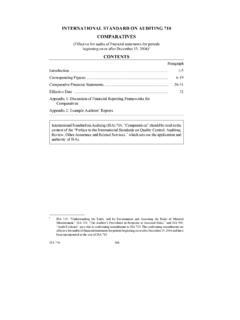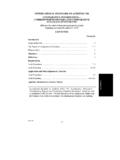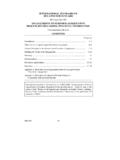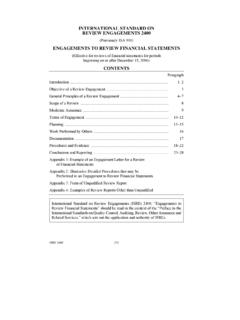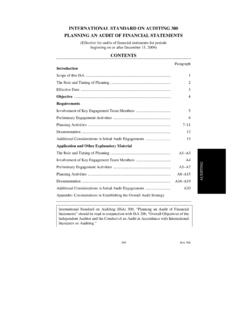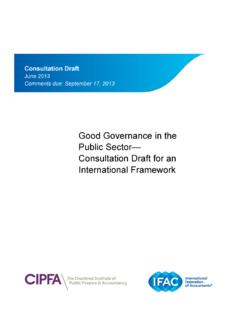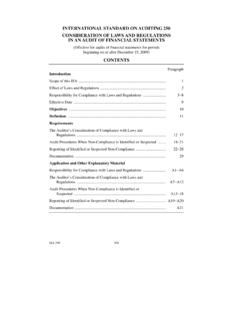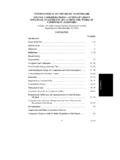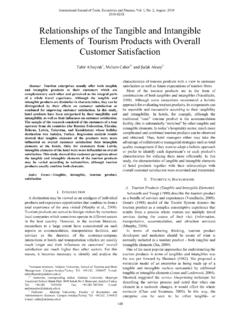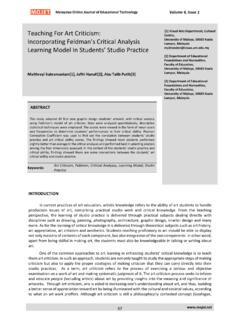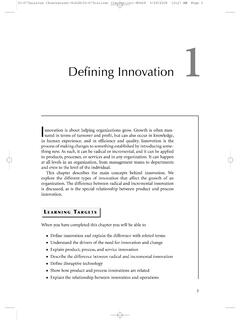Transcription of IAS 38 Intangible Assets - IFAC
1 International IPSAS 31. January 2010. Public Sector Accounting Standards Board Intangible Assets International Public Sector Accounting Standards Board International Federation of Accountants 545 Fifth Avenue, 14th Floor New York, New York 10017 USA. This International Public Sector Accounting Standard was prepared by the International Public Sector Accounting Standards Board (IPSASB), an independent standard-setting body within the International Federation of Accountants (IFAC). The objective of the IPSASB is to serve the public interest by developing high quality accounting standards for use by public sector entities around the world in the preparation of general purpose financial statements. This will enhance the quality and transparency of public sector financial reporting and strengthen public confidence in public sector financial management.
2 This publication may be downloaded free-of-charge from the IFAC website: The approved text is published in the English language. The mission of IFAC is to serve the public interest, strengthen the worldwide accountancy profession and contribute to the development of strong international economies by establishing and promoting adherence to high-quality professional standards, furthering the international convergence of such standards and speaking out on public interest issues where the profession's expertise is most relevant. Copyright January 2010 by the International Federation of Accountants (IFAC). All rights reserved. Permission is granted to make copies of this work provided that such copies are for use in academic classrooms or for personal use and are not sold or disseminated and provided that each copy bears the following credit line: Copyright January 2010 by the International Federation of Accountants (IFAC).
3 All rights reserved. Used with permission of IFAC. Contact for permission to reproduce, store or transmit this document. Otherwise, written permission from IFAC is required to reproduce, store or transmit, or to make other similar uses of, this document, except as permitted by law. Contact ISBN: 978-1-60815-057-1. 2. IPSAS 31 Intangible Assets . Acknowledgment This International Public Sector Accounting Standard (IPSAS) is drawn primarily from International Accounting Standard (IAS) 38, Intangible Assets published by the International Accounting Standards Board (IASB). It also contains extracts from the Standing Interpretations Committee Interpretation 32 (SIC 32), Intangible Assets Web Site Costs. Extracts from IAS 38 and SIC 32 are reproduced in this publication of the International Public Sector Accounting Standards Board (IPSASB) of the International Federation of Accountants (IFAC).
4 With the permission of the International Accounting Standards Committee Foundation (IASCF). The approved text of the International Financial Reporting Standards (IFRSs) is that published by the IASB in the English language, and copies may be obtained directly from IASB. Publications Department, 30 Cannon Street, London EC4M 6XH, United Kingdom. E-mail: Internet: IFRSs, IASs, Exposure Drafts and other publications of the IASB are copyright of the IASCF. IFRS, IAS, IASB, IASCF, International Accounting Standards, and International Financial Reporting Standards are trademarks of the IASCF and should not be used without the approval of the IASCF. 3. January 2010. IPSAS 31 Intangible Assets . CONTENTS. Paragraph Introduction .. IN1 IN4. Objective .. 1. Scope.
5 2 15. Intangible Heritage Assets .. 11 15. Definitions .. 16 25. Intangible Assets .. 17 20. Control of an asset .. 21 24. Future Economic Benefits or Service Potential .. 25. Recognition and Measurement .. 26 65. Separate Acquisition .. 32 39. Subsequent Expenditure on an Acquired In-process Research and Development Project .. 40 41. Intangible Assets Acquired through Non-Exchange Transactions .. 42 43. Exchanges of Assets .. 44 45. Internally Generated Goodwill .. 46 48. Internally Generated Intangible Assets .. 49 51. Research Phase .. 52 54. Development Phase .. 55 62. Cost of an Internally Generated Intangible asset .. 63 65. Recognition of an Expense .. 66 70. Past Expenses not to be Recognized as an asset .. 70. Subsequent Measurement .. 71 86.
6 Cost Model .. 73. Revaluation Model .. 74 86. Useful Life .. 87 95. Intangible Assets with Finite Useful Lives .. 96 105. Amortization Period and Amortization Method .. 96 98. Residual Value .. 99 102. 4. Intangible Assets . Review of Amortization Period and Amortization Method .. 103 105. Intangible Assets with Indefinite Useful Lives .. 106 109. Review of Useful Life Assessment .. 108 109. Recoverability of the Carrying Amount Impairment Losses .. 110. Retirements and Disposals .. 111 116. Disclosure .. 117 127. General .. 117 122. Intangible Assets Measured after Recognition using the Revaluation Model .. 123 124. Research and Development Expenditure .. 125 126. Other Information .. 127. Transition .. 128 131. Effective Date .. 132 133. Appendix A: Application Guidance Appendix B: Amendments to Other IPSASs Basis for Conclusions Illustrative Examples Comparison with IAS 38.
7 5. Intangible Assets . International Public Sector Accounting Standard 31, Intangible Assets is set out in paragraphs 1 133. All the paragraphs have equal authority. IPSAS 31 should be read in the context of its objective, the Basis for Conclusions, and the Preface to International Public Sector Accounting Standards. IPSAS 3, Accounting Policies, Changes in Accounting Estimates and Errors provides a basis for selecting and applying accounting policies in the absence of explicit guidance. 6. Intangible Assets . Introduction IN1. IPSAS 31 prescribes the accounting treatment for Intangible Assets . It is adapted for public sector entities from IAS 38, Intangible Assets .. Scope IN2. The IPSASB is currently developing a Conceptual Framework that will define an asset in the public sector.
8 The specific public sector issues which arise from powers and rights conferred by legislation, a constitution, or by equivalent means, need to be examined in detail in order to determine the appropriate accounting treatment. The IPSASB will reconsider the applicability of IPSAS 31 to these powers and rights when its Conceptual Framework is issued. Accordingly, IPSAS 31 excludes from its scope such powers and rights. IN3. IPSAS 31 incorporates, as Application Guidance, the guidance on accounting for website costs from the IASB's Standing Interpretation Committee's Interpretation 32 (SIC 32), Intangible Assets Web Site Costs, including illustrations of the relevant accounting principles. IN4. IAS 38 addresses Intangible Assets acquired by way of a government grant.
9 IPSAS 23, Revenue from Non-exchange Transactions (Taxes and Transfers) deals with this issue as it applies in the public sector. This Standard states that, where an Intangible asset is acquired through a non-exchange transaction, its cost is its fair value as at the date it is acquired in accordance with IPSAS 23. 7. Intangible Assets . Objective 1. The objective of this Standard is to prescribe the accounting treatment for Intangible Assets that are not dealt with specifically in another Standard. This Standard requires an entity to recognize an Intangible asset if, and only if, specified criteria are met. The Standard also specifies how to measure the carrying amount of Intangible Assets , and requires specified disclosures about Intangible Assets . Scope 2.
10 An entity that prepares and presents financial statements under the accrual basis of accounting shall apply this Standard in accounting for Intangible Assets . 3. This Standard shall be applied in accounting for Intangible Assets , except: (a) Intangible Assets that are within the scope of another Standard;. (b) Financial Assets , as defined in IPSAS 28, Financial Instruments: Presentation ;. (c) The recognition and measurement of exploration and evaluation Assets (see the relevant international or national accounting standard dealing with exploration for, and evaluation of, mineral resources);. (d) Expenditure on the development and extraction of minerals, oil, natural gas and similar non-regenerative resources;. (e) Intangible Assets acquired in a business combination (see the relevant international or national accounting standard dealing with business combinations).
